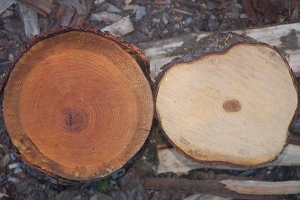What is the difference between spring wood and autumn wood?
Climate changes tend to influence the activity of the cambium ring in a stem. Cambium activated becomes more active during the spring season to result in springwood while less active during autumn season to result in an autumn wood.
The discussion provides detailed insight into the difference between springwood and autumn wood. Besides that, you will get to learn the difference between earlywood and latewood.

What Is a Spring Wood
Springwood is also known as earlywood. It is a type of wood formed during the spring season when the weather is favorable. The wood develops due to more active cambium activity which results in the formation of adequate xylem vessels.
These xylem vessels contain numerous pores and wider lumen. Besides that, the lumen does not contain much fiber and this is the reason why the stem grows radially with wide depth.
Characteristics of Spring Wood or Early Wood
- Cambium tissues are more active
- There plenty of xylem vessels with wider cavities
- The wood is formed during the spring season
- The lumen has fewer fibers
- The trachery elements are less thickened
- The wood is lighter in color
- The wood has a low density
- It happens at the beginning of an annual ring
What Is Autumn Wood
Autumn wood is also known as latewood. It is a type of wood formed when the weather is closed to the summer season and the activity of the cambium becomes less. This implies that there are few xylem vessels that are formed.
The unfavorable weather season of autumn and that of summer inhibit the activities of the cambium. The vessels tend to have a narrow lumen due to the thickening process. There are plenty of fibers in the narrow cavities.
Characteristics of Autumn Wood or Late Wood
- The density of the wood is high
- The xylem vessels have a narrow lumen
- The tracheary elements have thickened wall
- The xylem vessels have numerous fiber
- The wood is formed during the close summer and autumn season
- The wood tends to be darker in color
- This happens at the end of the annual ring
- There is a narrow strip in the annual ring
Comparison Chart: Spring Wood Vs Autumn Wood
| Basic Terms | Spring Wood | Autumn Wood |
| Meaning | Type of wood formed when the cambium activity are quite active during the spring season | Type of wood formed when the activity of the cambium is less during the autumn season |
| Condition | Developed during favorable conditions | Develop during unfavorable conditions |
| Location | At the beginning of an annual ring | At the end of an annual ring |
| Wood Color | Lighter | Darker |
| Xylem Fibers | Fewer in number | Fibers are plenty |
| Constitutes | Comprise the main part of the annual ring | Comprise a narrow strip in the annual ring |
| Density | Lower density | Higher density |
| Xylary Elements | Adequate in number | Less in number |
| Tracheary elements | Comparatively less thickened | Comparatively more thickened |
| Other Name | Earlywood | Latewood |
Core Differences between Spring Wood and Autumn Wood
- Springwood is formed during a favorable period of the year while autumn wood is formed during the unfavorable season of the year
- Springwood comprises a major part of the annual ring while autumn wood constitute a narrow strip of the annual ring
- Springwood occur at the beginning of the annual ring while autumn wood at the end of the annual ring
- Springwood contain larger and wider elements whereas autumn wood contain smaller and narrower elements
- Springwood has fewer fibers whereas autumn has plenty of fibers
- Springwood has low density whereas autumn wood has a high density
- The tracheary elements in springwood are less thickened while those of autumn wood are comparatively thickened.
- Springwood is lighter in color whereas autumn wood is darker in color
- Springwood is also known as earlywood whereas autumn wood is known as the latewood
- Springwood result in softwood whereas autumn wood result in a hardwood
Comparison Video
Summary
The core difference between springwood and autumn wood is that springwood is formed when the climate is favorable which encourages cambium activity to form numerous vessels whereas autumn wood is formed during an unfavorable climate of the year which reduces cambium activity hence resulting in few numbers of vessels.